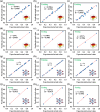Hybrid modeling for optimizing electrospun polyurethane nanofibrous membranes in air filtration applications
- PMID: 40715577
- PMCID: PMC12297687
- DOI: 10.1038/s41598-025-13159-0
Hybrid modeling for optimizing electrospun polyurethane nanofibrous membranes in air filtration applications
Abstract
Nanofibers have gained recognition as promising materials for air filtration due to their high surface area-to-volume ratio, adjustable porosity, and exceptional mechanical properties. However, optimizing their structural characteristics to maximize filtration efficiency while minimizing pressure drop remains challenging due to the complexity of the electrospinning process. This study presents an artificial intelligence-based methodology to establish relationships between electrospinning parameters, nanofiber morphology, and filtration performance. An advanced statistical approach is used to systematically collect and analyze data, followed by modeling these relationships using artificial neural networks (ANN) and analytical formulas to enhance predictive accuracy. A genetic algorithm (GA) is subsequently utilized to refine electrospinning parameters, facilitating the production of nanofibers with enhanced filtration efficiency and optimized airflow resistance. The optimized nanofiber membranes are validated experimentally to assess their real-world performance. The findings demonstrate the potential of AI-driven design in fine-tuning nanofiber structures for advanced air filtration applications. The optimized sample achieved a filtration efficiency of 96%, a pressure drop of 110.23 Pa, and a quality factor of 0.0297. This study underscores the effectiveness of combining AI with electrospinning to develop high-performance air filtration materials.
Keywords: Air filtration; Artificial intelligence; Nanofibrous membrane; Optimization; Polyurethane.
© 2025. The Author(s).
Conflict of interest statement
Declarations. Competing interests: The authors declare no competing interests.
Figures







Similar articles
-
Investigation of Multifunctionality of Electrospun Poly(vinyl alcohol) Nanofiber Membranes Incorporating Boric Acid and Nanoencapsulated Curcumin: Filtration Performance, Antibacterial Activity, and Environmental Impact.ACS Omega. 2025 Jun 10;10(24):26106-26117. doi: 10.1021/acsomega.5c03317. eCollection 2025 Jun 24. ACS Omega. 2025. PMID: 40584345 Free PMC article.
-
Optimization of needle punched nonwoven filter media for enhanced dust filtration performance.Sci Rep. 2025 Aug 29;15(1):31852. doi: 10.1038/s41598-025-17543-8. Sci Rep. 2025. PMID: 40883521 Free PMC article.
-
Management of urinary stones by experts in stone disease (ESD 2025).Arch Ital Urol Androl. 2025 Jun 30;97(2):14085. doi: 10.4081/aiua.2025.14085. Epub 2025 Jun 30. Arch Ital Urol Androl. 2025. PMID: 40583613 Review.
-
Hybrid Nanofibrous Membrane with Durable Electret for Anti-Wetting Air Filtration.Macromol Rapid Commun. 2025 Jul;46(13):e2401058. doi: 10.1002/marc.202401058. Epub 2025 Jan 27. Macromol Rapid Commun. 2025. PMID: 39871458
-
Artificial intelligence for detecting keratoconus.Cochrane Database Syst Rev. 2023 Nov 15;11(11):CD014911. doi: 10.1002/14651858.CD014911.pub2. Cochrane Database Syst Rev. 2023. PMID: 37965960 Free PMC article.
References
-
- Patel, D. K., Won, S. Y., Jung, E. & Han, S. S. Recent progress in biopolymer-based electrospun nanofibers and their potential biomedical applications: A review. Int. J. Biol. Macromol.293, 139426 (2025). - PubMed
-
- Razbin, M., Bagherzadeh, R., Asadnia, M. & Wu, S. Recent advances in wearable electromechanical sensors based on auxetic textiles. Adv. Funct. Mater.34 (49), 2409242 (2024).
-
- Razzaghi, D. et al. Chromic electrospun polymer nanofibers: preparation, applications, and the future. ACS Appl. Mater. Interfaces17 (3), 4247–4289 (2025). - PubMed
-
- Tao, D. et al. Electro-spun nanofibers-based triboelectric nanogenerators in wearable electronics: status and perspectives. Npj Flex. Electron.9 (1), 4 (2025).
-
- Sohrabi, M., Abbasi, M. & Karimi, M. Ultrafine and bimodal structured polyamide-6 nanofiber/nets membrane for air nanofiltration. J. Ind. Text.52, 15280837221079274 (2022).
LinkOut - more resources
Full Text Sources

